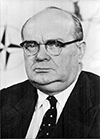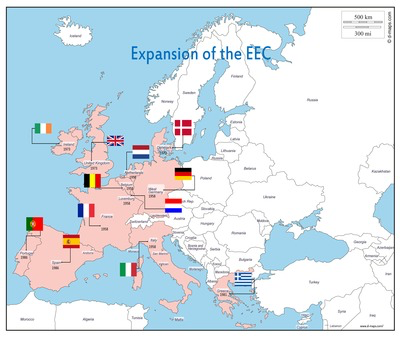The European Economic Community
The European Economic Community was an extension of the European Coal and Steel Community and a direct forerunner of the European Union. Initially containing six members, the EEC ended up having 13. The European Coal and Steel Community (ECSC) began as an attempt to forestall yet another military conflict between France and Germany. French Foreign Minister Robert Schuman proposed a common market for coal and steel, an agreement that would unite those two countries (West Germany, since the post-World War II division) in an economic and political association aimed at cooperation and common benefit. It was no accident that coal and steel had powered the war machines of the antagonists; however, the economic elements of the common market were more forward-looking and wide-ranging because of the abolishment of customs duties, subsidies, and other kinds of restrictive practices. 
Yet another Treaty of Paris came along in 1951, and the result was the creation of the ECSC. It wasn't just France or West Germany onboard; also joining were Belgium, Italy, Luxembourg, and the Netherlands. (All but Italy were already engaged in negotiations that would eventually create the Benelux Union.) The parliaments of all six nations voted in favor of creating and joining the ECSC and so it came into being, signed on April 18, 1951 and beginning operation on July 23, 1952. A suite of institutions supplied the infrastructure for the running of day-to-day business of the ECSC. The High Authority was the overall top organization; it was the equivalent of the executive branch of a representative government, and its members were appointed. Member nations sent representatives to be part of the Common Assembly and ministers to be part of the Special Council and judges to be part of the Court of Justice. The theory behind the intermingling of the duties of these four institutions was the idea of checks and balances. The base of most of these institutions was Luxembourg City. At the time, many political leaders sought more ways to join efforts. Two other high-profile entities proposed were the European Defence Community and the European Political Community. The former ended up being rejected by France and Italy (having been ratified by the other four member states) and so never took effect. As well, the French Parliament rejected the political entity and so efforts continued in that vein under different auspices. 
Jean Monnet of France had been elected as the first President of the ECSC. After his Parliament rejected the proposal for the European Political Community, he resigned his post and went to work behind the scenes. As well, Paul-Henri Spaak (right), who served as Prime Minister of Belgium and then President of the Common Assembly, coordinated efforts to produce a report on the possibility of a customs union. An international conference in his country in 1956 led to a series of agreements that produced the 1957 Treaty of Rome, which established a new entity titled the European Economic Community (EEC). Also coming into existence as a result of the Treaty of Rome was the European Atomic Energy Community (Euratom), which existed to promote market cooperation in the advent of nuclear power. 
The EEC began with the same six members: Belgium, France, Italy, Luxembourg, the Netherlands, and West Germany. In 1961 and 1962, four more nations applied to join: Denmark, Ireland, Norway, and the United Kingdom. Opposition from France halted progress on those applications for a number of years. In the meantime, Spain applied for membership but, because its government (under Francisco Franco) was a dictatorship, the EEC members refused, in 1964. As well, Greece, which had joined as an associate member in 1961, was tossed out because a coup in 1967 had replaced the country's representative government with a dictatorship. A change in government in France in 1969 resulted in the removal of opposition to expansion, and negotiations began anew. Norway did not join because its voters refused, in a 1972 referendum. On Jan. 1, 1973, however, Denmark, Ireland, and the U.K. did join the EEC. Two years later, Greece, a representative government once again, reapplied for membership; this application was successful, in 1981. Portugal and Spain, also turned democratic, applied in 1977 and joined in 1986. One of the first wide-ranging economic agreements was the Common Agricultural Policy, which began in 1962. This policy covered a wide variety of products and involved price controls, quotas, subsidies, and other methods of stabilizing markets and guaranteeing productivity and supply. A popular by-product was the availability to consumers of food at reasonable prices. The 1967 Merger Treaty folded the ECSC and Euratom into the EEC officially. Governing all of that was the Council of the European Communities, which consisted of one national minister from each member state. Membership on this council was temporary in that the makeup of the council changed according to the topics being discussed: If energy was the topic of discussion, then the national ministers for energy would make up the council at that time. A President of this council served for six months, and the presidency rotated through the member nations. The council had both executive and legislative powers. Comprising the executive was the Commission of the European Communities, which ran the daily business of the EEC. Members of the commission appointed a president, who was in charge of that daily business. The European Parliament was the legislative arm of the Council of the European Communities. Making up the Parliament were representatives of each member state's parliaments. Eventually, officials decided on a five-year term for members of the European Parliament. As well, the EEC had a judicial element, the Court of Justice of the European Communities. One judge from each member state served on this court, and the members of the court elected their own president. This court settled legal disputes between member states and ensured that laws were applied equally throughout the EEC. Policing the financial operations was the European Court of Auditors. This group, which was a later product of EEC business, had a primary duty of giving the Council and Parliament a yearly audit report. The member states of the EEC continued to discuss more opportunities for cooperation and common policies, most significantly in the 1986 Single European Act. After German reunification in 1990, the West German element of the EEC became (only) the German element. In the end, large-scale negotiations created the 1992 Treaty of Maastricht, which created the European Union, which superseded the EEC. |
|
Social Studies for Kids
copyright 2002–2025
David White




